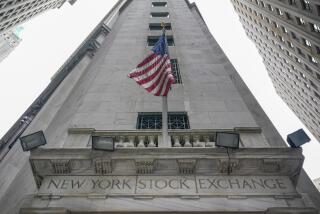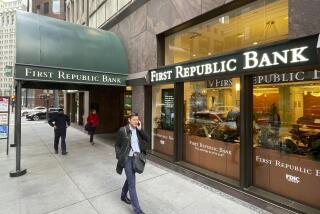Bank, Credit Union Fail; Japan Vows to Protect Depositors
TOKYO — Panicky depositors Wednesday helped trigger the first collapse of a Japanese commercial bank since shortly after World War II, part of a financial double-whammy that appeared to bring the nation’s festering banking crisis to a head.
The government announced that it will dissolve the bank, and it closed the country’s second-largest credit union--and then declared that the worst is over because no other financial institutions are both as large and as weak as those two.
Authorities also moved quickly to contain the damage, pledging that depositors at both failed institutions--Kizu Credit Union and Hyogo Bank--will get their money back and that the government will use taxpayer money if needed to ensure the system’s stability.
“Fear will not spread,” insisted Bank of Japan Governor Yasuo Matsushita.
Indeed, financial markets appeared to welcome the news. After falling modestly Wednesday during the depositors’ panic, Japan’s Nikkei 225 index rose 43.81 points to 18,027.67 in early trading today and the yen fell further against the dollar, good news for Japan’s exports.
“This shows that the government is taking care of the bad-loan problems,” said Masao Ariga, deputy general manager of the equity department at Daiwa Securities. “We can be confident now that there won’t be a financial crisis that could hurt the economy.”
The dollar’s climb to close at a seven-month high against the yen also supported the stock market, traders said, as investors bought auto and other export-oriented stocks. The dollar surged as high as 99.42 yen in early Asian trading today, the highest it has traded since Feb. 8. It closed Wednesday at 99.18.
The continuing banking crisis and generally fragile economic outlook in Japan mean the dollar can reach 110 yen by year’s end, said Hillel Waxman, manager of foreign exchange at Bank Leumi Trust Co. in New York.
Sei Nakai, deputy director of the Finance Ministry’s Banking Bureau, said that while there may be more failures among small institutions, there are no other large credit unions or regional banks in as weak condition as Kizu and Hyogo.
“The major problems” in this category, he said, “are all solved.”
The decision to eliminate the two institutions but guarantee their depositors’ funds--even in excess of the amount legally covered by deposit insurance--means that “the settlement of our big problem involving individual financial institutions is in sight,” Finance Minister Masayoshi Takemura told a news conference. “With this, the worst is behind us.”
Authorities decided to liquidate Hyogo, a major regional bank located in the western city of Kobe, after depositors started a run Wednesday on Kizu Credit Union, located in nearby Osaka. Both institutions were known to be weak, and officials decided that Kizu’s troubles would undermine Hyogo.
The devastating earthquake that hit Kobe early this year drove many of Hyogo Bank’s borrowers into bankruptcy and pushed down local land values, worsening the bank’s bad-loan problem.
Hyogo Bank will continue functioning normally until its operations are transferred to a new bank sometime next year, but stockholders will lose their investment, authorities said. Kizu Credit Union will immediately cease business except for customer withdrawals of deposits.
Finance Ministry officials have acknowledged that the Japanese banking system is burdened with at least $500 billion in non-performing loans, many of them backed by real estate that has plunged in value since the collapse of Japan’s late-1980s speculative boom.
Most major banks hold problem loans equal to about 10% of their total portfolios, but they also have sufficient cash flow and profits to gradually write off their losses over a period of years, officials say.
Concerns within Japan thus have focused not on the big banks but on two categories of weaker firms: housing finance companies, which take no deposits but instead borrow from other financial institutions in order to make real estate loans, and relatively small deposit-taking institutions, including regional banks and credit unions. Many of these institutions have credit or ownership links with the country’s large banks, while the entire system is tightly regulated by the Finance Ministry.
Some American analysts have expressed fear that if a domino effect triggered a sudden overall worsening of the bad-loan problem, Japanese banks might sell off foreign stocks and bonds to cope with the problem, which could result in a plunge in New York stock prices and a sharp rise in U.S. interest rates.
Speaking at a late-evening news conference, Nakai insisted that plans are developing for dealing with the overall problem.
While specific details of the plans remain to be worked out, Nakai said, the basic outline has been formulated for dealing with the one failed bank and four failed credit unions: Hyogo, Kizu, Tokyo-based Cosmo Credit Corp., which failed at the end of July under the pressure of the first panic by Japanese depositors since 1927, and two other Tokyo-based credit unions that failed late last year.
More to Read
Sign up for Essential California
The most important California stories and recommendations in your inbox every morning.
You may occasionally receive promotional content from the Los Angeles Times.










